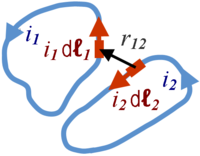Relative permeability: Difference between revisions
imported>John R. Brews (→Relation to forces: make notation agree with Ampere's equation) |
imported>John R. Brews (→Relation to forces: arrange to agree with source) |
||
| Line 19: | Line 19: | ||
''See also '' [[Ampère's equation]]. | ''See also '' [[Ampère's equation]]. | ||
The force exerted between infinitesimal current elements from two loops carrying currents ''I<sub>i</sub>'' and ''I<sub>j</sub>'' and immersed in a magnetic medium with relative permeability ''μ<sub>r</sub>'' is changed by a factor ''μ<sub>r</sub>''. The infinitesimal current elements have vector components ''i<sub>i</sub>''d'''ℓ<sub>i</sub>''' and ''i<sub>j</sub>''d'''ℓ<sub>j</sub>''' where the incremental lengths are directed along the wire at the location of the element, and pointing in the direction of the current. Grassmann's law for the force | The force exerted between infinitesimal current elements from two loops carrying currents ''I<sub>i</sub>'' and ''I<sub>j</sub>'' and immersed in a magnetic medium with relative permeability ''μ<sub>r</sub>'' is changed by a factor ''μ<sub>r</sub>''. The infinitesimal current elements have vector components ''i<sub>i</sub>''d'''ℓ<sub>i</sub>''' and ''i<sub>j</sub>''d'''ℓ<sub>j</sub>''' where the incremental lengths are directed along the wire at the location of the element, and pointing in the direction of the current. Grassmann's law for the force upon current element ''i'' exerted by current element ''j'' is:<ref name=Assis> | ||
See for example, {{cite book |title=Mach's principle: from Newton's bucket to quantum gravity |author=André KT Assis |editor=Julian B. Barbour, Herbert Pfister, eds |chapter=Equation (9) |pages=p. 162 |url=http://books.google.com/books?id=fKgQ9YpAcwMC&pg=PA162 |isbn=0817638237 |year=1995 |publisher=Birkhäuser Publishers}} | See for example, {{cite book |title=Mach's principle: from Newton's bucket to quantum gravity |author=André KT Assis |editor=Julian B. Barbour, Herbert Pfister, eds |chapter=Equation (9) |pages=p. 162 |url=http://books.google.com/books?id=fKgQ9YpAcwMC&pg=PA162 |isbn=0817638237 |year=1995 |publisher=Birkhäuser Publishers}} | ||
| Line 25: | Line 25: | ||
</ref> | </ref> | ||
:<math>d^2\mathbf{F_{ | :<math>d^2\mathbf{F_{ji}} = -i_i i_j \frac{\mu_r \mu_0} {4\pi} \frac{1}{r^2_{ij}}\left( \ (d \boldsymbol{\ell_i \cdot} d\boldsymbol{\ell_j})\mathbf{\hat{u}_{ij}}-( \mathbf{ \hat{u}_{ij}\cdot } d\boldsymbol{ \ell_i} )d\boldsymbol{\ell_j}\right ) \ , </math> | ||
as is readily derived from the [[Biot-Savart law]], and is consistent with space-time symmetry. Here '''û<sub>ij</sub>''' is a unit vector pointing from element ''j'' to element ''i'' along the line joining them, and ''r<sub>ij</sub>'' the length of this line. The force element is second order because it is a product of two infinitesimals. | as is readily derived from the [[Biot-Savart law]], and is consistent with space-time symmetry. Here '''û<sub>ij</sub>''' is a unit vector pointing from element ''j'' to element ''i'' along the line joining them, and ''r<sub>ij</sub>'' the length of this line. The force element is second order because it is a product of two infinitesimals. | ||
Revision as of 14:04, 20 April 2011
In physics, in particular in magnetostatics, the relative permeability is an intrinsic property of a magnetic material. It is usually denoted by μr. For simple magnetic materials, using SI units, μr is related to the proportionality constant between the magnetic flux density B and the magnetic field H, namely B = μr μ0 H, where μ0 is the magnetic constant. The relative permeability describes the ease by which a magnetic medium may be magnetized.
A related quantity is the magnetic susceptibility, denoted by χm, related to the magnetic permeability in SI units by:[1]
The relative permittivity μr may be greater than or less than 1. For simple media, if μr < 1 (χm negative), the medium is termed diamagnetic; if μr > 1 (χm positive) paramagnetic. Only classical vacuum has μr = 1 (exact). A typical diamagnetic susceptibility is about −10−5, while a typical paramagnetic susceptibility is about 10−4.
Relation to forces
See also Ampère's equation.
The force exerted between infinitesimal current elements from two loops carrying currents Ii and Ij and immersed in a magnetic medium with relative permeability μr is changed by a factor μr. The infinitesimal current elements have vector components iidℓi and ijdℓj where the incremental lengths are directed along the wire at the location of the element, and pointing in the direction of the current. Grassmann's law for the force upon current element i exerted by current element j is:[2]
as is readily derived from the Biot-Savart law, and is consistent with space-time symmetry. Here ûij is a unit vector pointing from element j to element i along the line joining them, and rij the length of this line. The force element is second order because it is a product of two infinitesimals.
Background
Maxwell reduced electrodynamics to the knowledge of charge and current distributions, and introduced the notion of material properties (constitutive relations) relating magnetic flux density B to magnetic field H and electric displacement D to electric field E. In implementing these relations, it should be noted that the use of a constant as the relative permeability of a substance is an approximation, even for quantum vacuum. A more complete representation recognizes that all media exhibit departures from this approximation, in particular, a dependence on field strength, a dependence upon the rate of variation of the field in both time and space, and a dependence upon the direction of the field. In many materials these dependencies are slight; in others, like ferromagnets, they are pronounced.
Notes
- ↑ For example see Yehuda Benzion Band. Light and matter: electromagnetism, optics, spectroscopy and lasers. John Wiley and Sons, p. 242. ISBN 0471899313.
- ↑ See for example, André KT Assis (1995). “Equation (9)”, Julian B. Barbour, Herbert Pfister, eds: Mach's principle: from Newton's bucket to quantum gravity. Birkhäuser Publishers, p. 162. ISBN 0817638237.


